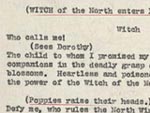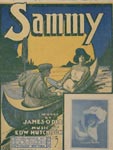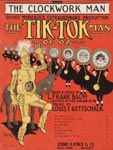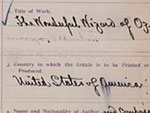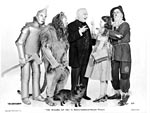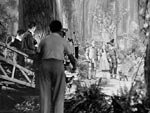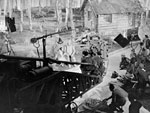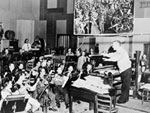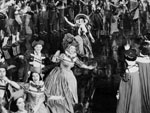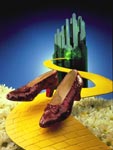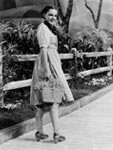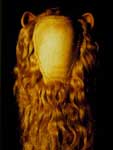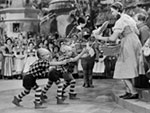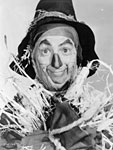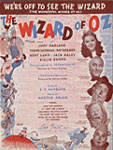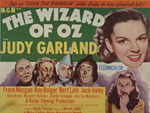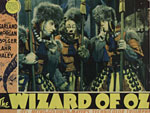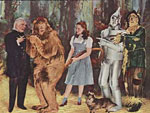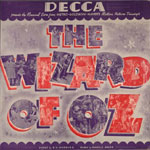
TO SEE THE WIZARD
|
||||||||||||||||||||||||||||||||||||||||||||||||||||||||||||||||||||||||
|
The first commercial films were four one-reel silent films produced in 1910 by the Selig Polyscope Company and based on the Wizard and some other Oz books. In 1914, Baum founded a Hollywood film company. Its five silent features and a few short subjects based on Baum's stories were not successful, and the studio closed in 1915. In 1925, Chadwick Pictures released a silent version of the Wizard,, which took great liberties with the book's plot and was a also a box-office failure. Next came the 1939 version, a rare instance in which a great book became a great film. Because of its many television showings between 1956 and 1974, it has been seen by more viewers than any other movie. In a recent People Magazine poll, it was chosen as the favorite movie of the twentieth century. Later Oz-related dramatizations include The Wiz (1975 and 1978), the Royal Shakespeare Company's 1987 stage production, an animated Japanese version (1982), Disney's Return to Oz (1985), and David Lynch's Wild at Heart (1990). |
|
Copyright Deposit Copy for
|
|
| |
|
Posters for Stage VersionThese colorful posters were published in 1903 to promote Fred R. Hamlin's musical extravaganza, The Wizard of Oz. Although the Tin Man is immediately recognizable, costume designs featured in the "Scarecrow" poster are in sharp contrast to the illustrations in the children's book published a few years earlier. That poster shows some of the new characters, including a chorus line of poppies, whom Baum added to the play. Comedian Fred A. Stone, who played the Scarecrow, autographed both posters; he signed the Tin Man poster on behalf of his costar, David C. Montgomery. |
|
|
|
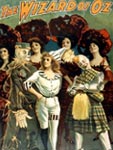 "The Scarecrow and Company."
"The Scarecrow and Company." Poster for Fred R. Hamlin's Musical Extravaganza, The Wizard of Oz. Cincinnati and New York: U.S. Lithograph Company, Russell Morgan Print, 1903. Prints and Photographs Division (29) |
| |
|
Music from the Wizard of Oz Stage ShowA number of the songs from the stage version of The Wizard of Oz became very popular. "Sammy" was the hit song of the show. The music became widely known through sheet music with colorful covers, the fastest way to circulate new songs at the turn of the twentieth century. |
|
|
|
|
| |
|
Music from The Tik-Tok Man of OzOn March 31, 1913, Baum opened a new theatrical production in Los Angeles entitled The Tik-Tok Man of Oz. The vaudeville-like formula he devised for his 1902 stage version of The Wizard of Oz also worked well with this venture, which played for five weeks in Los Angeles and later went to San Francisco and Chicago. Although well received on the road and described by one critic as "pure fun," the production never played in New York, as Baum had hoped. The producer felt that the production costs would be too high. |
|
|
Envelope addressed by L. Frank Baum
|
Registration Application for the
Musical Version of
|
Cast of 1939 Wizard of Oz FilmThe appearance of the main characters from the 1939 MGM film version differs greatly from those in the 1925 version. Because W. W. Denslow's illustrations were used in creating their costumes, they look more like the characters in the first edition of the book. The great popularity of the film has fixed these images in the minds of millions of people as the way the Oz characters should look. Although the five main stars each made a number of films, they are best remembered for their roles in the Wizard: (l-r): Jack Haley (1899-1979), the Tin Man; Bert Lahr (1904-1967), the Cowardly Lion; Frank Morgan (1890-1949), the Wizard; Judy Garland (1922-1969), Dorothy; and Ray Bolger (1904-1987), the Scarecrow. |
|
| |
|
Shooting the Wizard of OzLike most films of the 1930s, the Wizard of Oz was shot on sets constructed in the MGM studio in Hollywood. Because the set was so large, as many as nine cameras hidden in bushes or potted plants would be used to film one scene. The hidden cameras took close-ups, while the main camera, used to capture the whole scene, was on the end of a boom and was constantly moving. The extensive lighting equipment necessary for Technicolor photography in 1939 is very apparent in these behind-the-scenes shots. Banks of lights lined the floor of the stages and the catwalks above the actors and made the set uncomfortably hot, especially for the actors wearing heavy costumes. |
|
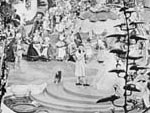 |
|
| Publicity stills showing The
Wizard of Oz film in production. |
|
| |
|
The Wizard of Oz Being FilmedIn this November 1938 production shot, Dorothy and the Scarecrow are seen inviting the Tin Man to join their journey to see the Wizard while the Wicked Witch of the West eavesdrops on their conversation. In the foreground, producer Mervyn Le Roy leans over to discuss the scene with Victor Fleming, seated in the director's chair. |
|
|
|
Recording the Oz MusicIn this publicity still, Herbert Stothart, house composer for MGM, conducts the studio orchestra in music for a scene later cut from the film, the return of Dorothy and her friends to the Emerald City with the Wicked Witch's broomstick. Stothart composed the background music for the film, as well as leading the orchestra in synchronizing the music with the on-screen action. |
Emerald City Townsman's Jacket from Wizard of Oz FilmThe wardrobe department at MGM made almost 1,000 costumes for the 600 actors in the Wizard of Oz. The ones for the main characters were highly elaborate, but even the costumes of the extras display fine workmanship and attention to detail. One of several in this design, this heavy felt jacket was worn by an Emerald City townsman. Other jackets were nearly identical, with the exception of the loop pattern on the yoke. In the film, the extras wearing this type of jacket were most prominently featured in crowd scenes in the Emerald City. |
|
|
|
Ruby Slippers from MGM FilmThere are five known pairs of the magical ruby slippers connected with the 1939 MGM film. Several designs of the footwear were developed, including one reminiscent of the silver shoes in The Wonderful Wizard of Oz book, before designers settled on hand-sequined pumps with flat jeweled bows applied to the toes. Originally silver in Baum's book, the slippers were purportedly changed to ruby to take full advantage of color photography. Each shoe is covered with red satin, to which 2,300 sequins are applied. This pair is in exquisite condition, and it is widely believed that they were used primarily for close-ups and possibly the climactic scene where Dorothy taps her heels together. |
Judy Garland as DorothyAt sixteen, Judy Garland won her only Academy Award, a special Oscar for the best performance by a juvenile, for her role in The Wizard of Oz. She later starred in a number of other films, winning Oscar nominations for A Star is Born (1954) and Judgment at Nuremberg (1961), and had a successful singing career. Her portrayal of Dorothy is her best-known and best-loved film role. |
|
|
|
Cowardly Lion Mane from
|
| |
|
Bert Lahr as the Cowardly LionAlthough many of the Oz film costumes were uncomfortable for the actors, Bert Lahr as the Cowardly Lion suffered most of all. His costume was especially heavy and hot. After takes, Lahr would remove the costume, and both he and the costume were blasted with air from blow dryers to cool him down and make the costume bearable for the next shot. |
|
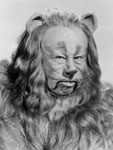 |
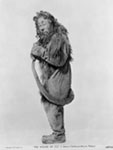 |
| Bert Lahr as the Cowardly Lion in The Wizard
of Oz. |
|
| |
|
|
|
Munchkin Costume from
|
Ray Bolger as the Scarecrow
|
|
|
|
Music for the 1939 FilmMGM decided to create new music for the 1939 film instead of using music from the stage version, in which most of the songs had little to do with the Oz story. In the film, the songs were designed to develop the characters or advance the plot, a practice that became standard, but was unusual for films at that time. On the basis of their successful writing for Broadway shows and previous films, the team of E. Y. "Yip" Harburg (1896-1981) and Harold Arlen (1905-1986) was hired as lyricist and composer. Together and in collaboration with others, such as the Gershwin brothers, the two produced many of the most popular songs from the 1930s through the 1950s. |
Lobby Card for 1955
|
|
|
|
Lobby Card for the 1939
|
Advertising Art for
|
|
|
|
Original cast recording for
|
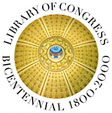 |
Library of Congress Contact Us (June 30, 2003) |
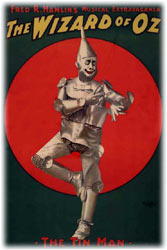 A
A